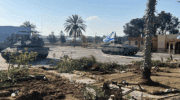Two articles below:
The protests in Gaza calling for Hamas to step down are fueled by a desire for certainty — that if Hamas simply surrenders, Israel’s genocide will stop. The tragedy is that these cries will go unheard, or even worse, will further fuel the war machine.
by Abdaljawad Omar, reposted from Mondoweiss, March 27, 2025
On March 18th, Israeli warplanes resumed their ferocious bombardment of Gaza—killing more than 800 Palestinians in a matter of days. After nine days of the renewed assault on Gaza, protesters in Beit Lahia took to the streets. Holding signs that read “No to genocide,” some among them also directed blame at Palestinian armed factions, particularly Hamas. In Israeli media, this footage was instantly seized upon and repackaged: proof, it claimed, that Israel’s campaign was working, driving a wedge between the population and resistance groups. This image of Palestinian protest—fragmented, desperate, and ambiguously positioned—has become central to Israel’s war strategy. It sustains a dual narrative: that military onslaught is necessary, and that Palestinians themselves have come to recognize the violence as of their own making. The war in Gaza is no longer only a campaign of destruction; it is a psychological operation, aimed at producing the image of surrender, of Palestinians claiming responsibility for their death.
This image also serves another function: it legitimizes Israel’s internal consolidation of power. The headlines in Israel now speak of a government reconfiguring itself, pursuing a dual strategy—the reordering of its institutional architecture and the continuation of its perpetual war. These aims are not distinct; each sustains the other. The genocidal campaign in Gaza is not merely a military exercise—it presents the possibility of ethnic cleansing, ensures a volatile regional environment, and opens the space for confrontation with Iran. Internally, the right-wing project—marked by judicial overhauls and the redrawing of civic boundaries—rests on the maintenance of emergency. The war, in turn, is rationalized by the need for national cohesion, a narrative of unity forged under siege, and signs of Palestinian capitulation only serve this larger right-wing narrative. Together, these dynamics form a closed loop: self-reinforcing and mutually dependent. Today, these are the headlines in Israel: the dismissal of Shin Bet head Ronen Bar (not in effect yet), the firing of the State Attorney General (not in effect yet), and the passing of a judicial overhaul bill set to take effect in the next Knesset. All happening while Israel is supposedly engaged in war of expansion in Syria and Lebanon, a war of decisive end of the Palestinian question, a war of enunciating itself as the only hegemon in the Middle East. A coup at home, and endless war.
And yet, even these protests—frail and fractured though they are—do not recover the figure of innocence in the Israeli imagination. The demonstrators in Beit Lahia who call for an end to the war, who cry out against genocide and Hamas, are not received as voices from outside the domain of guilt, of people yearning for life without the threat of death. Their appearance does not interrupt the narrative of Palestinian collective culpability that Israel carefully curated during this war; instead, it recodes it. In Israeli discourse, they are framed not as victims but as potential collaborators—Palestinians willing to betray their own, to confess the error of resistance, to kneel before power. The spectacle of capitulation becomes the final proof of guilt: not the guilt of having fought, but the guilt of having ever refused to submit. In this way, even dissent becomes instrumentalized. It does not interrupt the war; it reaffirms its logic. It renders the violence not only justified but necessary, confirming that surrender is possible, that fragmentation is real, and that domination can still be perfected.
Palestinian Dissent
Since the outbreak of violence between armed factions in Gaza in 2007, Palestinian society—both in Gaza and the West Bank—has endured a deep internal division, sustained by the presence of two competing political factions, each offering a distinct position vis-à-vis the colonial condition. The first, led by Mahmoud Abbas and the Palestinian Authority, advocates cooperation, collaboration, and accommodation—a strategy premised on negotiation, state-building, and security cooperation. The second, embodied by Hamas and other resistance factions, insists on confrontation, resistance, and defiance, viewing the colonial structure as an existential struggle. This schism is not simply institutional; it has penetrated the very fabric of Palestinian political life, structuring affect, discourse, and the conditions under which dissent, survival, and hope are negotiated.
This schism would come to play a dominant role in Palestinian political discourse in the wake of Tufan al-Aqsa, gradually polarizing both intellectual and public debate around three interrelated binaries: victory and defeat, responsibility and abandonment, resistance and survival. This discourse, however, was not wholly internal. It was also shaped—if not actively engineered—through sustained information and psychological warfare, particularly via Arab media outlets (funded by Gulf countries) that sought to assign responsibility for Israel’s genocidal campaign to the resistance itself. In these narratives, “defeat” was not merely an outcome but a permanent condition—a political horizon into which Palestinians were meant to settle, disarmed, disillusioned, and disciplined.
Within this domain, the voices of organized opposition in Gaza could be broadly grouped into three social and political categories. First, traditional family structures—powerful clans—who viewed the war as an opportunity to assert internal control, reestablish their dominance, and extract financial gain from incoming aid and reconstruction efforts. Second, the large social base of Fatah loyalists, particularly those aligned with Mahmoud Abbas or Mohammad Dahlan, who sought to exploit the situation to undermine Hamas by circulating talking points and narratives that blamed the resistance for the devastation. Their aim was to weaken Hamas politically while positioning themselves for potential governance in a post-war scenario. The third was the desperate desire shared by many ordinary Palestinians for the genocide to end, for the violence to stop, for anything that might restrain Israel’s unrelenting will to monstrosity.
The desire for the war to end—and to end immediately—has become the hallmark of what has been, by many measures, a largely effective psychological campaign where organized dissent on the part of Fatah colludes willfully or unwillfully with Israeli information and psychological warfare. Central to this effort is the assignment of blame, a kind of self-flagellating discourse that places the weight of responsibility squarely on the shoulders of resistance. Within this framework, genocide becomes not the crime of the perpetrator, but the consequence of Palestinian defiance. The narrative asks Palestinians to internalize guilt not for their subjugation, but for daring to resist it.
But beyond the discursive construction, its effectiveness also stems from the stakes involved—from the unbearable position of being held at gunpoint and asked to endure. This has been Gaza’s condition: a place where survival is always negotiated, where the cost of speech is death, and where utterances of self-renunciation are not new, nor always voluntary. They are produced under siege, under bombardment, and under the long shadow of a colonizer who demands submission as the price of breath.
Moreover, the relentless bombardment of Gaza and the wholesale destruction of its built environment have produced a radically altered reality. This new reality is twofold. First, it entails the severe weakening of governance structures and the capacity of Palestinian authorities to provide basic services or to manage society—particularly in the realms of crime prevention and the containment of personal retribution. Second, it has created a sense of political and administrative vacuum, further exacerbated by Israel’s targeted assassinations of government officials following its reneging on the ceasefire agreement. The erosion of institutional presence, both physical and symbolic, has left behind not merely a crisis of service provision, but a rupture in the very idea of order—an environment in which authority is increasingly fragile, and in which alternative forms of control and informal power are beginning to assert themselves in the absence of state infrastructure. The second is the improvisation of Gaza as a ground for buying loyalties and political allegiance by forces also hostile to Hamas or resistance more broadly. This is in part due to the hollowing out of people’s savings, assets, and the destruction of livelihoods. But perhaps more central is the fact that Gaza is no longer the Gaza it was before the war, as a result of the demographic and spatial shifts that have unfolded since the outbreak of violence.
These shifts in financial capacity of the population, the very moving around, and spatial composition mean that local politics in Gaza can no longer be read through the same lenses as before. The war has not only displaced people physically, but it has also disoriented the social fabrics and neighborhood-based solidarities that once underpinned political life. Areas that were once identifiable by their political leanings—whether toward Hamas, Fatah, or other formations—are now scattered, their populations fragmented and relocated, sometimes multiple times. Families from Beit Hanoun are now in Rafah, those from Shuja’iyya are in schools-turned-shelters in Deir al-Balah. Under such conditions, the very idea of a fixed “local base” loses coherence.
Political affiliations are strained by the urgencies of survival, and the logics of representation are fractured by the collapse of space itself. One cannot speak of local politics in the past tense, but only in a tense of suspension—of communities held in transit, forced to reconstitute political positions under siege, grief, and exhaustion. What emerges is not just a crisis of governance or resistance, but a crisis of the political itself. It does not bode well for any analyst to say for instance Beit Lahia where some of these small demonstrations occurred used to be a stronghold of Fatah or Hamas.
That said, what remains nothing short of miraculous is that after seventeen months of war, Palestinian society continues to exhibit profound forms of internal solidarity. Despite the unimaginable scale of destruction, the fracturing of space, and the erosion of institutional governance, people still find ways to share, to circulate resources, to be together in common. The idea of community has not vanished; it persists, stubbornly, even as the pressures of war increasingly push individuals toward the search for personal or familial salvation. Against a backdrop of fragmentation, dispossession, and relentless violence, the continued existence of communal life is not simply a residue of the past—it is an active form of resistance, a refusal to allow war to fully atomize the social fabric.
The Desire for Certainty
War is often described as a whirlwind—a collapse of past, present, and future into a single, indistinguishable moment. It suspends chronology, fragments coherence, and ushers in the primacy of disorientation, disorder, and uncertainty. In war, time ceases to unfold; it implodes. Meaning becomes erratic, and the structures that once anchored life—ritual, routine, memory, anticipation—are consumed in the immediacy of survival. For many Palestinians certainty, even if the certainty is one of defeat, or surrender is desired.
These demonstrations are a cry for certainty—for order, for coherence, for anything that might stabilize a world spiraling into ambiguity, especially the unbearable uncertainty of whether one will live or die, whether friends and loved ones will make it through the night. They are not merely political gestures, but existential pleas: attempts to reassert legibility in the face of chaos, to grasp at fragments of meaning when meaning itself is under siege. And yet, they are also performances of agency—acts of asserting some form of control, even when that control inadvertently reinforces the very machinery of slaughter they seek to halt.
This is also the tragedy of life under the monstrous. A life in which the Other is omnipresent, haunting every breath like an angel of death—yet the only face to which you can cry, object, or plead is the face that mirrors your own, marked by the same language, the same features. The machinery of extermination has always thrived on such arrangements: it manufactures the conditions for necrosis, for fratricide, for the internalization of blame. It does so by being everywhere, yet also remaining out-there, both present and absent. It renders the victim complicit not in deed but in despair, folding resistance into self-flagellation, and sorrow into self-reproach. Yet the cries, even of surrender will tragically still go unheard, or at worse, will only fuel the war machine further.
<speaker-mute_
Abdaljawad Omar is a Palestinian scholar and theorist whose work focuses on the politics of resistance, decolonization, and the Palestinian struggle.
‘We want to live’: Rage at Israel fuses with ire at Hamas as protests rock Gaza
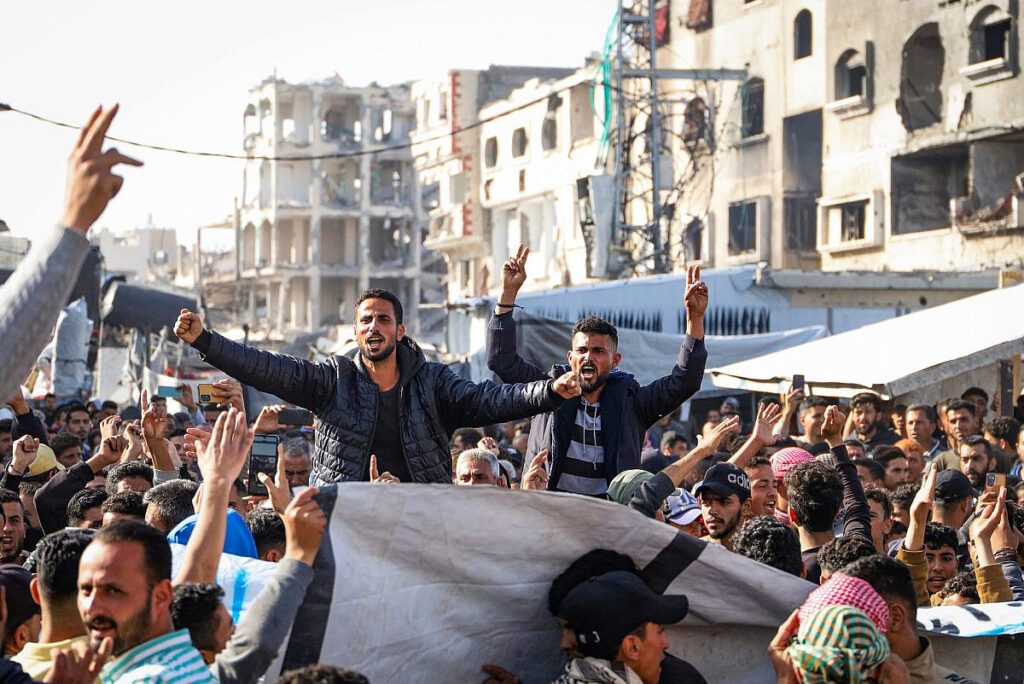
In the enclave’s largest demonstrations in years, Palestinians called for an immediate end to the war and elections to choose a new leadership.
“If the missiles don’t kill us, famine will. We want to change this reality.”
by Ruwaida Amer, reposted from +972 Magazine, March 27, 2025
For the past two days, Palestinians across the Gaza Strip have taken to the streets to demand an end to Israel’s genocidal onslaught and to Hamas’ rule of the territory. Beginning in the northern city of Beit Lahiya, demonstrations quickly spread to other parts of the enclave including Shuja’iyya in the north, Nuseirat and Deir Al-Balah in the center, and Khan Younis in the south. The protests are the largest since the war began, and the most significant public display of dissent against Hamas in Gaza in years.
The demonstrations were triggered by new Israeli orders to evacuate Beit Lahiya and the surrounding areas, as the military expands its latest ground incursion. Residents spontaneously went out onto the streets on Tuesday to vent their anger at being forcibly displaced yet again, reflecting the population’s increasing desperation after Israel shattered the fragile ceasefire last week.
While holding Israel responsible for the slaughter of more than 50,000 people over the past year and a half, and for subjecting the Strip to a longstanding blockade that has further intensified during the war, the protesters are also directing their ire at Hamas: they are calling on the group to do everything in its power to stop the bombing before stepping aside to allow for free elections.
“I participated in the demonstrations from the moment they started,” 50-year-old Raed Tabash, from Khan Younis, told +972. “I chanted and screamed and vented my inner rage. We’ve been living under siege for 20 years. There’s no work and no future for our youth. Our children are growing up and we don’t know what awaits them. How many children have been killed during this war? Are we giving birth to our children only for missiles to kill them in the most horrific way?
“I’m tired of being repeatedly displaced,” Tabash continued. “I have no money left to buy food for my children, and even if I did, the markets are empty. We have become physically and psychologically ill. We want a complete and final end to the war, and for elections to be held so we can choose a party other than Hamas to govern us. I will not stop going out and demanding an end to our suffering until all of this stops and there is a change in the government in Gaza.”
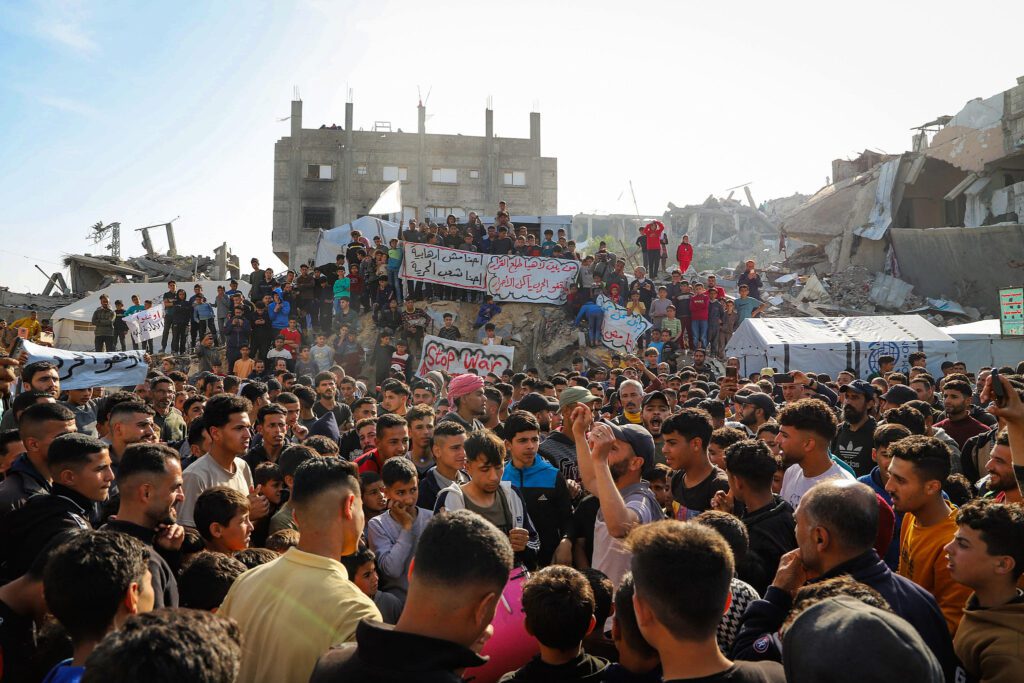
Despite his criticisms of Hamas, however, Tabash emphasized that his main struggle is against the Israeli occupation. “If we were freed from the shackles of the occupier and from its repeated wars, we and our children would live in safety and peace,” he stated. “The occupation is responsible for our suffering.”
Ahmed Thabet, 29, participated in protests this week in Beit Lahiya. “As a young man, I have a future: I want to work, get married, and have a family,” he told +972. “A year and a half have passed since the war started and there has been no change in the reality that the occupation has imposed on us. There is only a daily routine of killing, destruction, and crying over our loved ones. If the missiles don’t kill us, famine will. We want to change this reality.
“The world thinks that all of Gaza is Hamas, which is false,” Thabet continued. “Hamas is part of Gaza; some of us agree with it and some disagree with it — this is normal. We are calling for elections, to change who rules us. This is our right as a people who want to change our reality and our future. The war must stop, and Hamas’ rule must be replaced.
“Keep in mind that in the West Bank, which is ruled by the Palestinian Authority, Palestinians suffer from displacement, arrests, and home demolitions [by the Israeli military],” he went on. “This means that the occupation is against the Palestinian people, not against their political affiliation. I hope the United States will support us in our right to live and stop supporting and perpetuating the war. We will help the negotiators to successfully reach a solution to end it.”
Munir Baraka, a 45-year-old from Deir Al-Balah, hit back at the cynical support for the protests from the Israeli media and politicians. “We don’t care what they say, nor that they are encouraging us to demonstrate. We are against the occupation and their war. We are calling for a change in Hamas’ rule, as is our right — just as the Israelis are calling for the overthrow of Netanyahu’s government.
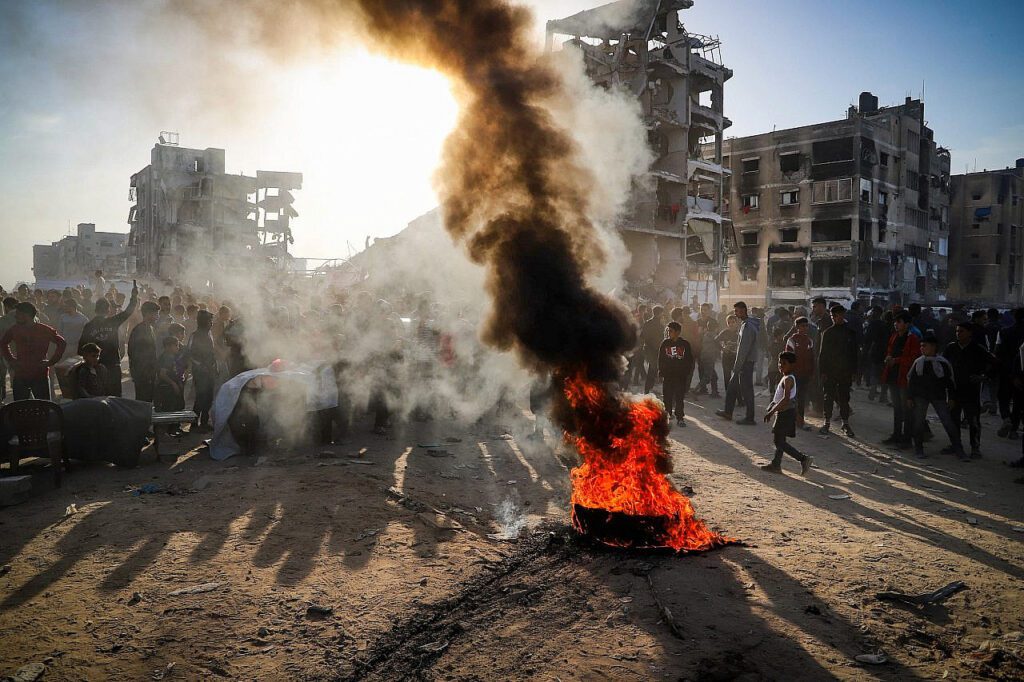
“Hamas has ruled Gaza since 2007, and it is time for its role to end,” he continued. “We don’t want the Palestinian Authority either, because we see what it has done in the West Bank. We want a responsible body that cares about our lives and our future. No party has the right to force us to live through successive and continuous wars.
“We want the world to see Gazans as human beings like them — a free, peaceful, civil people who want to live,” Baraka went on. “None of us wants death. Whoever calls us terrorists to justify the occupation killing us with heavy missiles is wrong. We support any negotiations to stop the war, and we will continue these demonstrations until our demands are met.”
‘It’s clear the sound of our empty stomachs bothered you’
Beyond the protests on Gaza’s streets, Palestinians also took to social media to defend the demonstrators against accusations that they were doing the bidding of Israel or the Palestinian Authority.
“Those who took part in the spontaneous demonstrations in northern Gaza are the same people who starved, surviving on animal fodder and wild grass,” Sami Abu Salem wrote in a post on Facebook. “They are the ones who endured and foiled [Israel’s] displacement plan. They are the ones still waiting for their children to be pulled from the rubble. They are the ones whose names belong on the honor roll.
“I believe their protest was spontaneous and has nothing to do with the Palestinian Authority or anyone else,” he continued. “Accusing them of treason is shamelessness and moral and political bankruptcy.”
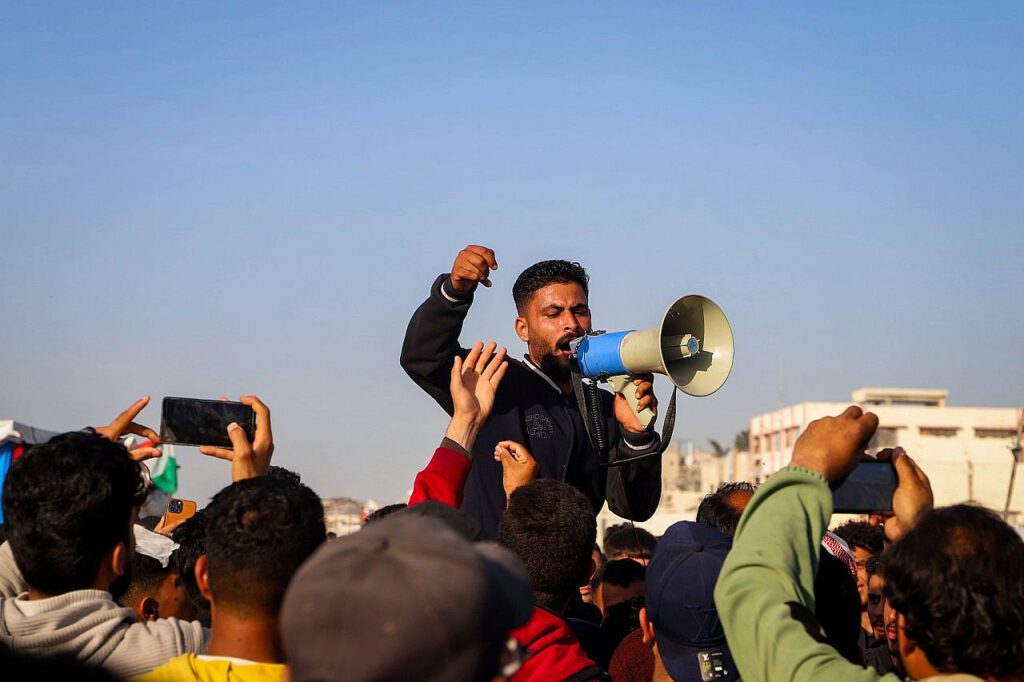
Others directly addressed those opposing the protests. “Dear ones who have the right to speak about us … We apologize for the unexpected surprise, as we are people of flesh and blood like you,” Ahmed Mortaja wrote on Facebook. “We tried to fast without complaining about the lack of food and drink for more than 18 months, but it is clear that the sound of our empty stomachs bothered you. We apologize for that.”
Some, like Saleh Fayaz, expressed anger and frustration with Hamas while acknowledging that in the current circumstances it is the only thing preventing Gaza’s total eradication. “I have enough criticism of Hamas to write a book of five hundred pages or more,” he wrote. “But since October 7, Hamas has not been the target. It has only been the pretext.
“Had Hamas been completely annihilated, Israel would have continued its war against the Mujahideen Brigades and the Popular Front, turning every raised rifle into an ‘imminent danger,’” he continued. “Israel does not want disarmament, but rather the annihilation of existence. If Hamas surrenders its weapons without a real guarantee of a path toward liberation and statehood, Israel will transform the Strip into a darker version of Sabra and Shatila.”
Fayaz also responded to social media posts by pro-Israel influencers expressing support for the protests and urging Gazans to join them. “Calls by Zionists like Edy Cohen to demonstrate are likely an attempt to hijack the movement and undermine the protesters,” he said. “Those who might have joined the protests would [instead] hold back so as not to be seen as following Israeli orders.
“I believe Israel wants to preserve the image it has projected to the world, that all of Gaza is of one color and deserving of death because [its people supposedly] support ‘terrorism,’” he added. “What it doesn’t want to show is the real picture emerging — that Gaza is in fact multi-colored.”
Ruwaida Amer is a freelance journalist from Khan Younis.
RELATED ARTICLES:
- Weaponizing starvation, Israel seeks full control over Gaza aid distribution
- The Last Chapter of the Genocide
- 18 March 2025: The day 183 children in Gaza were massacred by Israel
- The Israel-Hamas Ceasefire Farce
- WATCH: Hamas will uphold agreement — interviewed senior official
- Israel doesn’t care about the captives. It always planned to reboot the genocide
- Hamas explained why it attacked Israel on October 7, 2023
- WATCH: What was happening in Gaza BEFORE the Hamas attack…



